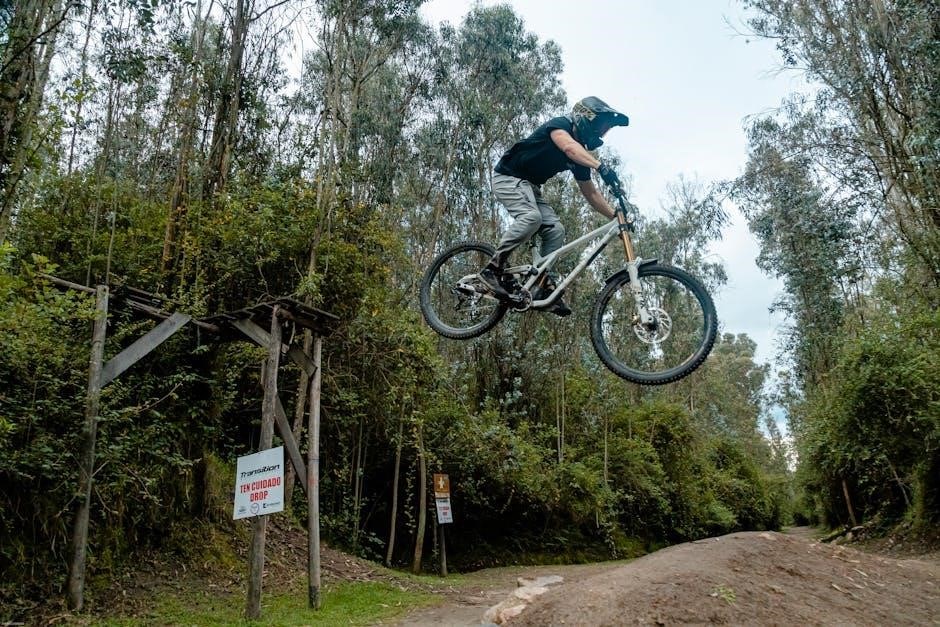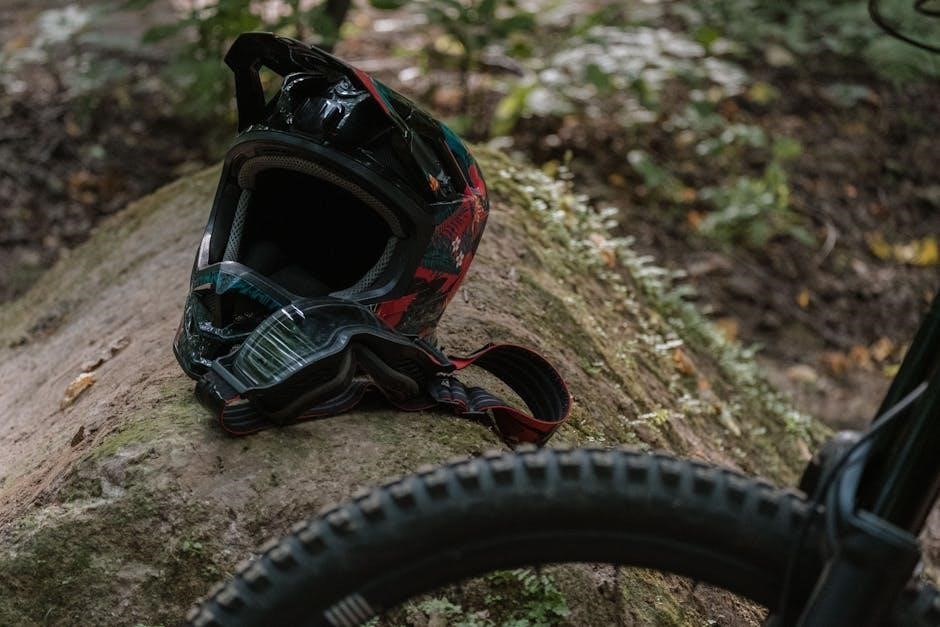Proper mountain bike sizing is crucial for optimal performance, comfort, and safety․ This guide explores key factors like frame size, standover height, and seat adjustments to ensure a perfect fit․
Why Proper Bike Sizing Matters
Proper bike sizing is essential for maximizing comfort, efficiency, and control while riding․ A bike that fits your body dimensions ensures optimal performance and reduces the risk of discomfort or injury․ Incorrect sizing can lead to poor handling, strained posture, and fatigue, making even short rides unpleasant․ Additionally, a well-fitted bike improves pedaling efficiency and maneuverability, which are critical for both casual trails and competitive racing․ Whether you’re a beginner or an advanced rider, the right size ensures a safer and more enjoyable experience․ Consulting a mountain bike sizing chart or a professional fitter can help you make an informed decision tailored to your needs․
Overview of Mountain Bike Sizing Charts
Mountain bike sizing charts provide a structured guide to help riders select the appropriate frame size based on their height and riding preferences․ These charts typically categorize bikes into sizes such as Small, Medium, Large, and Extra-Large, with corresponding standover heights and seat adjustments․ Manufacturers often vary slightly in their sizing, so it’s crucial to refer to specific charts for accuracy․ The charts may also consider factors like wheel size, which can affect fit, and riding style, ensuring the bike’s geometry aligns with the rider’s needs․ By using these charts, riders can narrow down their options and find a bike that offers the best combination of comfort and performance for their unique requirements․


Understanding Frame Size

Frame size determines the bike’s fit and handling․ Measured in inches or categories like Small, Medium, and Large, it’s crucial for a comfortable and efficient ride․
How to Measure Your Height for Frame Size
To measure your height for frame size, stand straight against a wall with your feet flat and shoulders relaxed․ Use a level tool or book to mark the top of your head, then measure this distance with a tape measure․ Ensure accuracy by wearing your cycling shoes, as this affects standover clearance․ Record your height in inches or centimeters and compare it to manufacturer sizing charts․ This measurement is a key starting point for determining the ideal frame size, though other factors like standover clearance and seat height also play a role in achieving the perfect fit․
Frame Size Categories: Small, Medium, Large, and Beyond
Mountain bike frame sizes are typically categorized as Small, Medium, Large, and sometimes Extra-Large or Extra-Small․ These categories are designed to accommodate a range of rider heights, ensuring optimal fit and comfort․ While exact measurements vary by manufacturer, most sizing charts provide height ranges for each frame size․ For example, a Small frame might suit riders between 5’2″ and 5’6″, while an Extra-Large frame is ideal for taller riders over 6’0″․ Always cross-reference your height with the manufacturer’s sizing chart for accuracy․ Testing the bike in person, if possible, ensures the best fit and riding experience․ Proper frame size is essential for performance, comfort, and safety on the trails․

Standover Height and Clearance
Standover height measures the space between the rider and the bike when standing over it․ Adequate clearance ensures safety, comfort, and optimal maneuverability on the trails․
How to Measure Standover Height
To measure standover height, wear your cycling shoes and stand over the bike with feet flat on the floor․ Ensure the bike is on a level surface․ The clearance between your crotch and the top tube should be at least 1-2 inches for road bikes and 2-4 inches for mountain bikes․ This ensures safety and optimal maneuverability․ Proper clearance allows you to dismount quickly and maintain control while riding․ Always check standover height with your cycling shoes on, as this provides an accurate measurement for your riding position․
Importance of Adequate Standover Clearance
Adequate standover clearance is essential for safety, control, and comfort while riding․ Proper clearance ensures you can dismount quickly in emergencies, reducing the risk of injury․ It also allows for better maneuverability, especially on technical terrain․ Standover clearance affects your bike’s handling and stability, as it influences how you interact with the bike․ Insufficient clearance can lead to discomfort or loss of control, while excessive clearance may result in a less efficient riding position․ Always ensure the clearance matches your riding style and preferences for optimal performance and safety on the trails․

Seat Height Adjustment
Seat height adjustment is crucial for optimal comfort and efficiency․ Proper leg extension and standover clearance ensure safety, preventing injury and enhancing control while riding․
How to Adjust Your Mountain Bike Seat Height
To adjust your mountain bike seat height, start by loosening the seat clamp bolts․ Measure your inseam and set the saddle height so there’s a 25-30mm gap when wearing cycling shoes․ For optimal comfort, ensure your leg is nearly fully extended at the pedal’s lowest point, with a slight bend in the knee․ Tighten the clamp firmly and test the bike by riding slowly to confirm stability․ Proper seat height enhances pedaling efficiency, reduces fatigue, and prevents discomfort․ Always double-check clearance and adjust as needed for different riding styles or terrain conditions․
Optimal Seat Height for Different Riding Styles
Seat height should be tailored to your riding style for maximum comfort and performance․ For cross-country riding, a slightly higher seat height is preferred to maximize pedaling efficiency on flat or uphill terrains․ Trail and enduro riders often opt for a moderate seat height to maintain maneuverability while descending․ Downhill riders may lower the saddle to improve stability and control at high speeds․ Adjustments should also consider standover clearance and ensure proper leg extension․ Experimenting with small changes can help find the perfect balance for your specific needs, ensuring optimal power transfer, comfort, and control across various riding conditions․

Wheel Size and Its Impact on Sizing
Wheel size significantly affects bike fit and handling․ Common sizes like 27․5″, 29″, and 29″ offer varying benefits, impacting stability, maneuverability, and performance for different riders and terrains․
Popular Wheel Sizes for Mountain Bikes

Mountain bikes commonly feature 27․5″, 29″, and 29″ wheels, each tailored to specific riding styles․ 27․5″ wheels offer agility and quick acceleration, ideal for technical trails․ 29″ wheels provide superior stability, excelling on rough terrain․ The choice depends on rider height, skill level, and preferred terrain․
How Wheel Size Affects Fit and Handling
Wheel size significantly impacts both fit and handling․ Larger wheels, such as 29″, offer better roll-over capabilities and stability at high speeds but may require longer frames, affecting standover height․ Smaller wheels, like 27․5″, provide quicker acceleration and tighter handling, making them ideal for technical terrain․ Riders’ height and inseam also influence the fit, as larger wheels raise the bike’s standover height․ Proper wheel size ensures optimal comfort and performance, balancing maneuverability and stability based on riding style and terrain․
- Larger wheels improve stability but may reduce agility․
- Smaller wheels enhance maneuverability but sacrifice speed on rough trails․

Riding Style and Skill Level Considerations
Riding style and skill level greatly influence mountain bike sizing․ Aggressive riders may prefer longer frames for stability, while XC riders opt for shorter frames and quicker handling․
- Beginners benefit from more forgiving geometries․
- Advanced riders may prioritize precision and control․

How Riding Style Influences Bike Size
Riding style and terrain significantly impact mountain bike size selection․ Cross-country (XC) riders prioritize lightweight, efficient bikes with shorter frames for agility․ Trail and enduro riders often opt for medium to large frames, balancing stability and maneuverability․ Downhill riders prefer longer, slacker frames for high-speed control․ Riders focusing on technical terrain may choose smaller frames for easier handling, while those favoring speed and flow prefer larger frames․ Wheel size also plays a role, with 29-inch wheels suited for speed and 27․5-inch for agility․ Ultimately, bike size should align with the rider’s style, ensuring optimal performance and comfort on the trails․
Adjusting Size for Beginners vs․ Advanced Riders
Beginners often benefit from a slightly larger frame for stability and ease of handling, while advanced riders may prefer a smaller, more responsive bike for precise control․ Standover height and seat position should be adjusted to ensure comfort and confidence․ For beginners, prioritize a bike with a lower standover clearance to reduce the risk of injury in case of a fall․ Advanced riders can opt for a higher saddle height to maximize pedaling efficiency and power transfer․ Wheel size preferences also vary: beginners may find 27․5-inch wheels more manageable, while advanced riders often favor 29-inch wheels for speed and rollover capabilities․